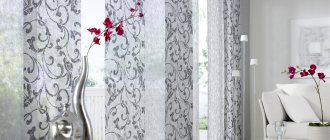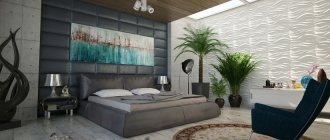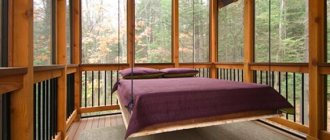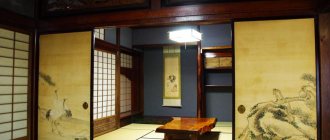Japanese-style room interior: distinctive features
The Japanese style fits perfectly into domestic small-sized apartments, because the citizens of the empire are not spoiled by open spaces and are accustomed to harmoniously arranging their life on modest living spaces.
The interior for Japanese taste has a number of distinctive features that make it easily recognizable:
- minimalism - the room lacks diversity and variety of colors, finishing materials, not to mention decorative accessories;
- traditionally, the Japanese sit on the floor - they drink tea, talk, sleep on low futon mattresses, so there cannot be any high cabinets, tables or huge sofas in the room, there is only the necessary minimum of furniture in the room;
- Hidden niches or transformable furniture are provided for storing things;
- the geometry of the room changes thanks to light partitions or folding screens;
- finishing materials are exclusively natural, no plastic.
Historical facts
Traditional Japanese houses were built to suit the local climate, which was warm and humid. The basis of the dwelling was a light wooden frame, an earthen floor and a thatched roof. Instead of internal walls, sliding partitions (fusuma) were used.
The life of the Japanese of distant eras was a “floor” life. There were no chairs or beds in his house; everything was placed on rugs. During the daytime, the Japanese family gathered around a low table, at which meals and tea drinking took place. The decoration of the house was completely ascetic. The room was decorated with a stone lantern, which also served as a lamp.
Since ancient times, Japanese people have been accustomed to sleeping on the floor or on a straw mat. The pillow was a log or a wooden headrest in which a rotating cylinder was mounted. But the rich Japanese preferred tatami mats, although at that time they were harder and more uncomfortable than modern futons. The family covered themselves with one blanket.
Since the 17th century, residents of a distant eastern country began to use bedding. Cotton futons filled with wool, cotton or linen appeared in their everyday life. At first they were very expensive, so only the wealthiest Japanese purchased them.
Despite the asceticism inherent in local life, the striking Japanese style had a fascinating atmosphere, which it has retained to this day. So, a modern tatami bed:
- Consists exclusively of natural materials;
- It is characterized by a strict, laconic design: a low, wide platform on which there is a hard tatami mattress;
- Helps those who have problems with the spine;
- Can serve as a place for a meal;
- It has a protruding platform on which you can place books, candles and other necessary items.
A Japanese bed will create the illusion of spaciousness in your room, fill it with the peace of unhurried Japanese philosophy, and also add oriental charm to the interior.
Machiya - Japanese urban houses
Machiya are traditional wooden town houses that, along with village houses (noka), represent Japanese folk architecture (minka).
Machiya in Kyoto for many centuries represented the standard that defined the form of Machiya throughout the country. That is, if you want to see real machiya, then go to Kyoto.
| Rice. 8-9. Machiya in Kyoto |
A typical Machiya is a long wooden house with a front facing the street. The house itself can be one, one and a half, two or even three floors high.
At the front of the building there was often a store, which was closed from the outside with doors that rose or moved apart. This part of the house constituted the "shop space" of the house.
The rest of the house is the so-called “living space”, which consisted of rooms for various purposes, including storing goods, receiving clients and guests, cooking or relaxing.
| Rice. 10. Machiya schematic illustration |
| Rice. 11-12. Urban Japanese houses |
Nowadays it is not comfortable to live in traditional Japanese houses, they do not meet modern living requirements and gradually such houses are disappearing, somewhere they are preserved as historical monuments. In the photo below there is such a house, its appearance, in contrast to the above pictures, is dull.
| Rice. 13. Traditional Japanese house today |
Decor
This style originated from a 1997 FRUiTS magazine article in which famous model Aki Kobayashi described and showed off her personal style. After this, girls all over Japan began to dress as unique and original as possible. The decor does not have clear canons, because the whole idea is uniqueness, but the image should be as flashy and shocking as possible.
Usually girls put on a huge amount of the brightest jewelry, hairpins, rivets, chains, choose bright neon colors of clothes, dye their hair in all the colors of the rainbow, tie soft toys to themselves and “hang” themselves with decor in every possible way.
Japanese bedroom for the perfect holiday.
Even if you don't like the traditional Japanese style, there are some important features you can use. For example, shoji screens, which are often used, as well as sliding doors. They are both stylish and convenient as these doors are comfortable and beautiful. Screens can be used as a dividing element in a dressing room or as a decorative element.
A Futon bed, bamboo rugs and flower sprigs will fit perfectly into a Japanese themed bedroom. The emphasis of interior designs should be made only from natural materials. Light colors such as beige, sand or white are suitable for the walls, and the floor can be made in a contrasting dark color. Wooden flooring is highly recommended. The ceiling can be designed creatively with exposed wood beams, which will enhance the natural sense of appeal and spirit of Japan.
Asian themed bedroom - furniture and decorations.
Depending on your preferences, a Japanese bedroom can be minimalist or exotic. Chinese style interior decoration offers brighter and more contrasting colors - red, gold accessories and decorative elements. If you want to create a more relaxed atmosphere in your home, choose a fresh and vibrant Japanese style with simple lines and green plants.
Japanese style is a combination of nature and natural floral decorations, painted trees and exotic birds, more suitable for wall decor. Plants fit perfectly into Japanese style and are an important decorative element. Orchids, wisteria, bamboo and bonsai trees will suit you. Furniture should be made of wood and without unnecessary decorative elements. Choose bamboo or rosewood for light furniture with a dark finish that fits into Asian themed interiors.
Basic principles of Japanese bedroom design.
Japanese style in interior design is considered universal because it can be neutral and subdued, bright and exotic at the same time. Japanese bedrooms are minimalist, while Japanese-style interiors can be more dramatic. However, harmony is the main principle of Asian styles. Elements such as flooring, furniture, lighting and decoration must work together to create a balanced interior. Japanese style is especially suitable for small bedrooms as the interior is designed to create a feeling of space and dimension. Oriental interiors are known for the fact that every object exists for a reason and has a special place. Disturbance in Asian bedrooms is unthinkable. Clear forms, functionality, natural materials and perfect order - these are the pillars of Asian-style interior design.
Despite the similarities, there are some features that define Japanese and Chinese styles. Chinese interiors reflect thousands of years of tradition and culture. Although modern lifestyle and interior design allow a certain amount of freedom when designing. For example, colors have a deep symbolic meaning, and black, beige, red and gold are typical interior colors. Green with yellow and blue are also in the color scheme options. In general, Chinese bedroom designs have a wider range of colors and color combinations. Reds and blacks, accents of gold and high-gloss lacquer surfaces can create impressive interiors with contrasting effects, while white, beige and brown will work in a bedroom with a relaxed atmosphere. Symmetry is also of great importance in Chinese philosophy. A bed in the center of the room with nightstands placed the same distance from the walls is a typical bedroom layout. Furniture and accessories should be chosen based on color - vases, screens, lighting, wall decorations - each element should be related to the others to create a sense of harmony.
Beautiful wall decoration. Elegant Asian style bedroom in neutral colors.
Sophisticated Asian interior and wall decoration. Bright red accent wall.
Modern interior in Asian style. Artistic wall painting. Symmetry and balance.
Wall photo wallpaper, living Japan. Beautiful bonsai tree as a decorative element.
Based on materials from: https://deavita.net/asian-themed-bedroom-ideas.html
Bedroom Decorations
There should be very few of them, so as not to turn an imitation of style into a lack of taste. The following would be appropriate:
- dwarf bonsai trees;
- ikebana;
- images of hieroglyphs;
- fans;
- floor vases;
- caskets;
- netsuke figures.
If all the walls in the bedroom are plain, one of them can be decorated with photo prints with traditional Japanese scenes - bamboo branches, flying cranes, cherry blossoms. The same motifs usually decorate screens. Mirrors should not be present in such a bedroom, as should any smooth shiny surfaces. Textures reminiscent of natural fabrics and paper are appropriate.
There are no windows as we understand them in Japanese homes; they are replaced by external partitions. Since you will still need curtains to decorate the windows in the bedroom, it is better to choose roller blinds of a suitable color. For the curtain material, you can use thick fabric or a woven mat. Japanese curtains are also suitable - straight sliding panels of fabric.
A bedroom decorated in this way will definitely give you a feeling of peace and tranquility, your sleep will be sound and calm, and your awakening will be cheerful and joyful.
Peculiarities
Tatami is a traditional Japanese bed, consisting of a base of a strict and simple shape, as well as a very hard mattress - a futon, which in itself can be used as a full-fledged sleeping place. The main feature of such a bed is its low location above the floor level. In the classic version, tatami is made only from natural wood or bamboo.
The design is completely free of decorative elements; a real Japanese bed is the natural color of the wood, simplicity and severity of lines. Modern bed models that imitate tatami have a very wide frame, the edges of which usually protrude beyond the mattress.
The bed frame is supported by strong squat legs, usually four of them. The exception is large-sized beds, which have an additional leg attached in the middle to give the piece of furniture increased stability. All legs are specially shifted to the center of the bed - this allows for the effect of hovering above the floor.
The distinctive features of Japanese-style beds include the following:
- frame made of natural wood;
- low location of the mattress, almost near the floor;
- clear geometric shapes, with straight lines and angles;
- complete lack of decor and decorations;
- straight and low backs, rectangular headboards;
- thick legs; models without legs have built-in drawers for linen (along the entire perimeter);
- absence of metal and plastic parts.
Description
Solid pine bed.
Japanese style tatami bed.
Back height: 71 and 33 cm.
| Size | 90 × 190/200 | 120 × 190/200 | 140 ×190/200 | 160 × 190/200 | 180 ×190/200 |
| Dimensions | 98x202/212 | 128x202/212 | 148x202/212 | 168x202/212 | 188x202/212 |
The “Tokyo” cabinet for this bed can be purchased at a price of 4,500 rubles.
Bed Tatami bed Tokyo
can be done:
— made of solid beech + 100% to the price; — from solid ash + 150% to the price; — made of solid oak + 200% to the price.
Appearance and decor
When decorating a place to sleep in the Japanese spirit, avoid a large, luxurious bed with frilly elements or a model in a bright color. A traditional tatami bed denies volumetric dimensions, any decoration, gilding, or unnatural color. The stock in this stylistic direction has simple geometric silhouettes without frills, as well as a color that is as close to natural as possible.
Form
The bed structure is a grounded wooden frame with slats. Low legs (usually 4 of them) are located closer to the middle. If there is a fifth leg, then it is located in the center. The advantage of a Japanese bed is its stability. However, this plus becomes a disadvantage when a neat housewife needs to move furniture.
A very convenient model, which is complemented by a side shelf. It can accommodate the necessary items: your favorite book or a cup of tea. Often the shelf is located at the head. Some models have a linen compartment in the form of drawers or a lifting mechanism. If the bed has a threshold, then it plays a purely decorative role.
Decor
To create a “Japanese” atmosphere in your bedroom, you cannot limit yourself to an exclusively low bed. It is necessary to take into account other nuances that will help reflect the desired environment:
- A Japanese bedroom should not be overloaded with decorative elements;
- It is allowed to hang a picture on the wall. But decorating a room with family photos is not customary in Japan;
- A fan, vase and figurine will add a little zest to the interior;
- A mat will look organic with a low bed.
The foundation of the Japanese way of life is a golden rice mat with a peculiar smell. She fills the room with the spirit of the Land of the Rising Sun.
Color and textiles
Just one look at a wide, low Japanese-style bed will transport you to the atmosphere of an East Asian night. This is achieved through a visual effect. Japanese interiors do not welcome the brightness of artificial colors. Of course, it may contain reddish or orange shades, but as separate fragments.
Preference is given to natural tones:
- Brown;
- White;
- Black;
- Salatovoy;
- Pink.
The color scheme should be simple and strict. Usually these are 1-3 main shades. Textiles in a Japanese bedroom are also discreet. Silk or cotton fabric is suitable for bed linen. It is desirable that it be monochromatic, but a discreet print is allowed.
Futon mattress
Many models come with a futon, a traditional Japanese cotton mattress stuffed with wool and cotton. The filler sometimes includes rice straw. All components of the mattress are selected in such a way that it retains its shape for many years.
The hard material is covered with a cotton cover, impregnated with a product that protects a person from various parasites and microbes. After sleeping, the futon is rolled up and then stored in a cabinet with sliding doors.
Rice straw is placed into the mattress using a unique technology. This helps to relax the neck and back, ensuring complete rest of the body during sleep.
So, the Japanese style bed stands out:
- Laconic forms;
- Smoothness;
- Non-textured surface;
- Materials of natural origin;
- Restrained color palette;
- Availability of a special mattress.
The discreet appearance of the ascetic model will certainly appeal to lovers of minimalism and will fit perfectly into a restrained interior.
Samurai House
The samurai's house was surrounded by a wall with a gate; the larger it was in size and the better decorated, the higher the samurai's status. The structure of the house is based on supporting pillars, the house is rectangular in plan, and it itself is raised on stilts 60-70 cm from the ground, which protected it from dampness and mold.
| Rice. 4. Samurai residence |
| Rice. 5. Nomura Samurai House, Kanazawa |
| Rice. 6. Photo of a modern house in Japanese style. House of a modern samurai |
| Rice. 7. Modern house with Japanese-style architectural elements |
The house visually resembles a panel frame house, but only partially disassembled depending on the season of the year. The outer walls, which face the street, are fixed and motionless, and the wall facing the courtyard was made sliding. This wall was called amado, it looks like a shield made of closely knit wide boards, installed in cold weather or at night before shoji.
Processing bed blanks
In order to make a bed with your own hands, you first need to process the blanks of all the parts for it. Using a plane, it is necessary to remove all the main irregularities and protrusions from the boards. In addition, the proposed bed layout implies that the thickness of the boards should not exceed 4 cm. You may have to remove excess wood.
Prepare the legs. Japanese-style beds usually have a low height (in this case, 30 cm). But you can make these parts according to your own measurements.
Cut the parts of the workpieces from the processed materials. You will need 4 legs, parts for the sides of the frame, 1 piece each for the headboard and footboard. Moreover, the footboard should be about 8 cm wider than the headboard. The back side will be inserted between the side parts, while on the front side it is necessary to form angular cuts equal to 45°. Exactly the same bevels must be made at the front ends of the side panels. A square will help you form an even bevel. If the cut turns out to be uneven, then it is finalized with a plane.
The frame of a Japanese bed should be a perfect rectangular shape. To give it reliability, corners are usually used. But in this case, furniture legs will serve as such corners.
To do this, you need to mark the middle on the leg blank. Wood is then removed from the top to form a groove. Its height and depth should be equal to the parameters of the sidebar. Thus, when you put the sidewall in the groove, at the bottom of the frame there will be a block 15 cm long - this will be the leg of the bed. The remaining 15 cm will play the role of a corner.
All workpieces are carefully polished, irregularities and burrs are removed.
The frame is assembled with self-tapping screws. Stiffening ribs for the logs under the mattress are secured with bolts from the inside. If your bed is wide enough, the entire structure must be tightened with a longitudinal beam, which is located in the middle. It can be made from a fairly thick beam or use a ready-made metal crossbar for this. Next, the headboard and slatted base of the mattress are attached.
At the last stage of work, the bed is carefully sanded, painted or stained, and varnished. Glue the softener and secure the headboard upholstery.
Ceiling
The ceiling in a Japanese bedroom should have a rectangular configuration. The shape and individual details can also be square - these are the traditions of Asian culture.
The design is done using natural materials. Despite the fact that artificial materials can also be used to decorate the ceiling, it is better to give preference to fabric or wood.
The color palette is only light. Many decorate the ceiling and walls in a single color scheme, using light natural tones. Discreet patterns are allowed.
In Japanese bedrooms, beam and suspended ceilings are most often designed. In the first case, the surface is divided into square or rectangular elements by beams fixed to the painted ceiling, and then the ceiling is covered with textiles or paper.
Tension structures on a profile made of metal or plastic are fixed on a fabric or film panel.
The Armstrong system, which is a structure consisting of profiles and decorative plates, is also popular.
The more sections on the ceiling in the room, the more spacious the bedroom will seem
It is important that the lintels contrast with the ceiling; they are designed from dark wood or wood-imitating materials
Walls
In Japanese traditions, walls are often wooden frames covered with rice paper.
In our conditions, to maintain the color, wallpaper that matches the style is enough. The maximum imitation can be achieved by covering the walls with a suitable fabric and upholstering them with wooden slats.
Materials for double bed
Products are made from different materials. Mostly this is wood or its derivatives - MDF, chipboard. Metal is also used in the manufacture of products.
Wood species selected are durable, resistant to moisture and temperature changes - for rooms with radiators this is important, since with excess heat the panels can dry out and crack
Any double bed should have a comfortable covering for sleepers. As a rule, in most samples it is a recessed mattress with slats at the bottom. The material and content of such a “liner” should be environmentally friendly and not too soft.
Another option that can be found in a furniture store is a double bed without a mattress included. In this case, you buy it yourself. The assortment may include different models - regular or thick mattresses up to 10 cm high.
In most classic-type structures, the bottom is made with slats or plywood and is necessarily limited around the perimeter by low sides that will hold the mattress. Care of bed surfaces should be regular.
Double bed "Japan style 2"
Carpentry workshop "Goldfinchwoods" offers to purchase a Japanese-style bed "
Japan style 2" made of solid natural wood. The Japanese call them “tatami,” which translated into Russian means “hard folding mat.”
According to the tradition that developed many centuries ago in Japan, a sleeping place had a universal purpose and was used not only for sleeping. Most often, the bed was the only piece of furniture, so during the day they laid out books and other things on it, and did everyday things.
Today, Japanese-style beds are predominantly low models made of natural wood without decorative elements or unnecessary details. In most cases, they do not even have a headboard.
Residents of the Land of the Rising Sun who sleep on a hard, low mattress can boast of health and longevity. Perhaps this is why the Japanese-style low bed is so popular - buy
It is preferred not only by young people, but also by older people as the main place to sleep.
Features of Japanese-style beds
Japanese philosophy is the harmony of man and nature. When decorating their premises, they use a calm palette, giving preference to natural colors - brown, black, light green, pink, white. It is advisable to limit their number and use no more than three color combinations in the interior.
A traditional Japanese tatami bed should be made of wood of a discreet color. In this case, the bed must be located low above the floor. Choose a bed width of at least 120 cm: in this case, it will look stylish and sleep on it will be as comfortable as possible.
Do not use any decor or decorations, as well as metal and plastic parts. A headboard may be present, but it is of a small height, sufficient to fix the pillows.
When buying a mattress, you can be guided by Japanese wisdom, which states that sleeping on a firm base is the most beneficial. But this requirement is not categorical: if you prefer softer variations of mattresses, order with exactly these parameters.
a Japanese-style bed in your bedroom
model Japan style 2" you can on our website. We recommend choosing colors that are close to natural: in this case, you are guaranteed to preserve the traditions that the Japanese have worshiped for many centuries.
Japanese style beds
- only made of wood!
Perhaps this is a condition
– one of the most important. Natural solid wood is a distinctive feature of furniture used in Japan. To produce it, they process coconut wood.
The production facility makes beds from wood species that grow in the Russian climate - oak, beech, ash, pine. They are of the same quality as coconut palms and will last for many decades.
We produce wooden low beds in Japanese style especially for you – buy
You can customize this model. Fill out the application and we will get to work taking into account the selected wood species, size, color, and configuration.
Materials and their combinations
Interior design in the “Japanese” style is an entire philosophy based on the unity of nature and man. Therefore, in Japan they produce furniture from environmentally friendly coconut palm wood without the use of various dyes and varnishes. Some examples are quite creative: they are created in the form of beds, upholstered in high-quality leather, these are:
- Buffalo leather – prestige, durability;
- Eco-leather – noble appearance, environmental friendliness;
- Microfiber leather – elegance, high water resistance, excellent breathability.
Thanks to the combination of materials that radiate life-giving energy, this unusual and natural bed will make the bedroom interior fashionable, extraordinary and comfortable, as well as fill it with aesthetic meaning and peace. Although Western manufacturers make adjustments to the development of new models, they adhere to the general concept of the South Asian style direction.
Features of the interior in Japanese style
A Japanese-style interior is a special philosophy, a way to know yourself, get closer to nature and dissolve in it. That is why Japanese-style design denies the pretentiousness of the decor, avoids excesses and artificial (non-natural) materials. There are several features that shape the Japanese style:
minimalism is the basic and main rule that is observed in everything related to the interior. No unnecessary things, frills - only the necessary things that will be useful in everyday life. Most things are hidden in built-in cabinets or closed shelves, painted to match the walls - so they are practically indistinguishable. This is why the space seems empty and uncluttered
In a Japanese interior, everything is in its place, and there are no frills
Wood, stone, water and details neatly arranged on shelves - an unsurpassed symphony of exquisite taste
the power of emptiness - by European standards, Japanese interior is empty space, with a minimum of furniture. In fact, there is a lot of air here, energy circulates freely, which, according to Japanese tradition, is vital
Light, space and laconicism are the basis of a stylish, comfortable interior
color scheme - no bright, flashy colors. Japanese style is a cloudless sky, sea foam and withered autumn foliage, cherry blossoms, a full moon and coastal stones. The predominant shades are natural, pastel: beige, milky, pearl, dark brown, sand, cream. Often there are interiors designed in contrasting black and white tones. Red and green colors are used extremely rarely, and then only in dark or very light shades, not bright, muted
Pleasant, discreet natural colors create a real philosophy of comfort
unity with nature - in a traditional Japanese country house, the landscape is a direct continuation and complement of the interior, which is why the walls facing the terrace are made sliding. When decorating an apartment, the Japanese give exceptional preference to natural materials, using wood instead of stone. Instead of massive walls, there are light partitions or screens made of bamboo or rice paper. The flooring is wooden, the same reliable and durable bamboo, on the walls there are wooden panels, the curtains are exclusively natural, made of linen or silk.
Natural materials make this bathroom truly luxurious
A living bush growing from the ground right in the room is a bright element in a restrained Japanese bedroom
furniture - in a Japanese house there is no special furniture for sleeping or sitting; all these functions are performed by a special mattress - a futon. Since the entire design in the Japanese style is designed specifically for a seated person, the simplest idea of Japanese furniture is tables, chairs, a sofa and beds whose legs have simply been sawed off. All Japanese furniture is low, squat, but at the same time quite comfortable. The Japanese cabinet mimics the walls, the facades are smooth, without decorations, expressive carvings, and the fittings are inconspicuous. All books are placed in special chests - tansu, a kind of chest of drawers on wheels. A modern Japanese bed is no longer just a mattress or tatami, in fact, it is a bed with a headboard familiar to a European, only very low, without legs
Luxurious Japanese-style bedroom with minimal furniture
accessories play a secondary role in Japanese interiors, but they are mandatory, without them the design will be imperfect. There should not be many of them - the Japanese place only one niche on one wall (where they place a vase, box, netsuke, ceramic dishes, fine porcelain) or one painting, which is the main focus. According to the Japanese, hanging several paintings on one wall at once is equivalent to listening to several songs at the same time. The decor can be mats, bamboo rugs, silk drawings, bedspreads decorated with hieroglyphs, Buddha figurines, fans, scrolls with wise sayings, interior dolls
Japanese-style interior details are elegant and neat
The lighting is not bright and does not hurt the eyes. Reminiscent of a lunar glow, it is soft, with a rich play of light and shadow, halftones relieve nervousness and stress, immerse you in a trance, and have a relaxing effect. Most often, sconces and floor lamps are used as lighting fixtures, with traditional Japanese designs applied to the lampshades. Lampshades for lamps (chandeliers) are made of wood, parchment, natural silk, and much less often - porcelain or glass.
In the muted light of the bedside lamps, interior elements create whimsical shadows
https://youtube.com/watch?v=Aner9Ts-qYk
Signs and general concept of style
Mysterious and original Asian traditions have always inspired interior design specialists to come up with original ideas. Merging with the natural world, lightness and the effect of spaciousness, naturalness - this is how one can characterize the Japanese style.
Philosophers have always sought to find a balance between yin and yang, the elements of air and earth, light and dark. All this is reflected in the contrasting combination of shades of traditional Japanese design. The most popular color combinations are wenge and beige, snow-white and black.
To decorate a bedroom in a Japanese style, you need to follow the following principles:
Minimalism. The spacious room creates a microclimate that promotes the achievement of physical and mental harmony. The strict configuration of furniture and the rejection of unnecessary decorative elements set the mood for relaxation. In such an environment it is easy to forget about worries.
Naturalness. The closeness to the natural world is emphasized through the use of environmentally friendly materials of natural origin:
- wood;
- linen and cotton fabrics;
- bamboo;
- vines;
- rice paper;
- reed
Naturalness is also manifested through natural shades: cherry, emerald, chocolate.
Functionality. Arranging the room with comfortable shelves, cabinets of a simple design, and built-in cabinets with sliding doors helps to rationally organize the space.
Japanese-style room for a teenage girl
Children's rooms are often decorated in Japanese style, as this guarantees a safe living space for the child, creates an environment conducive to the development of creative abilities and looks original.
The decoration of the room uses exclusively natural materials, the basic colors are cream, beige, which in a girl’s room can be diluted with pink, cherry or blue. Tatami or sisal rugs are appropriate on the floor in a nursery.
Unlike a Japanese-style room for adults, bright, cheerful accents are acceptable in the design of a child’s room.
A good decoration for a children's room would be wall painting; the drawing could depict cherry blossoms or a landscape in a graphic manner.
When choosing furniture for a children's room, you should choose durable wooden products:
- the closet is low, elongated horizontally, or replace it with a dressing room, separating it from the room with screens;
- Desktop;
- Instead of a low bed, you can put a special soft futon mattress on the floor, which can easily be turned into a chair, a place to play, or rolled up and put away.
If the children's room is not an independent room, then it can be separated using curtains
You can decorate a room in Japanese style with your own hands; the photos in our article will help you in this exciting task. Such work will not require significant material costs and even a teenager can do it, although the help of adults will not hurt:
- on a neutral-colored wall, black and white painting is done in the style of anime or manga, popular Japanese comics;
- apply anime graffiti style drawings to the wall;
- hang replaceable posters;
- display a collection of characters from your favorite TV series in a prominent place.
An interesting solution for a child's room would be an anime-style drawing.
Various details will support stylistic unity:
- light low table;
- an open bookcase for books and toys;
- a lacquered cabinet or a small chest of drawers for small items under a mirror in a simple frame.
In the room of a teenage girl who is fond of Japanese style, a variety of technical innovations, located in a prominent place (home theater, stereo system, game consoles, etc.) will be appropriate.
Room for a teenager
Coloring and design
Japanese style is characterized by simplicity and minimalism. This leaves an imprint on the design of bedroom furniture. The design of the bed does not allow for flashy voluminous decor. Asceticism is emphasized in everything: frame, mattress, bed linen. The palette is limited to calm, muted tones. To ensure that the appearance of the furniture remains harmonious, no more than three shades are used simultaneously for decoration. Natural wood, leather and textiles allow you to fulfill this rule. Most often the color scheme includes:
- beige;
- brown;
- grey;
- black;
- white;
- salad.
Types of adult and children's stylish beds, their characteristics
To maintain the Asian style, the bed must fit organically into the interior of the bedroom. To do this, create an appropriate environment in the room. Design support is provided by paintings, photographs, vases, mats, panels, figurines, and lamps. All decorative elements should also be in the spirit of the East.
The visual perception of the bedroom is influenced by textile accessories. First of all, these are bed linen and bedspreads. According to the laws of oriental design, tatami are covered with several types of capes, which differ in shape, size, and texture. Their choice is very scrupulous. For sewing bedspreads and bed linen, only environmentally friendly natural fabrics are used - silk, cotton. The color should be monochromatic or with an inconspicuous small pattern.
Light
The rooms are illuminated with natural soft light penetrating through the translucent washi in the partitions. Currently, paper is being replaced with frosted glass or plastic. With the shoji extended, the house is flooded with an abundance of sunlight.
There are simply no windows familiar to a European in a traditional Japanese house. Textile curtains will also be inappropriate. If windows open 24/7 cause discomfort, use sliding “Japanese style” curtain panels, as in the photo.
When lighting the bedroom, it is recommended to avoid overhead artificial light. For evening lighting, use the middle and bottom lines of the lamps. Twilight light should be hidden, diffused, and create a calm, contemplative atmosphere.
Paper lamps (akari) can hardly be called a light source. The simple design and dim glow are reminiscent of moonlight and rather than dissipate, rather emphasize the twilight. When choosing lampshades, avoid metal of European designs, give preference to natural ones: a bamboo frame combined with rice paper.











